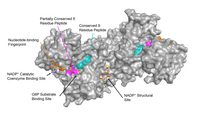
Photo from wikipedia
It was recently demonstrated that a bioelectrochemical system (BES) with a redox mediator allowed Pseudomonas putida to perform anoxic metabolism, converting sugar to sugar acids with high yield. However, the… Click to show full abstract
It was recently demonstrated that a bioelectrochemical system (BES) with a redox mediator allowed Pseudomonas putida to perform anoxic metabolism, converting sugar to sugar acids with high yield. However, the low productivity currently limits the application of this technology. To improve productivity, the strain was optimized through improved expression of glucose dehydrogenase (GCD) and gluconate dehydrogenase (GAD). In addition, quantitative real‐time RT‐PCR analysis revealed the intrinsic self‐regulation of GCD and GAD. Utilizing this self‐regulation system, the single overexpression strain (GCD) gave an outstanding performance in the electron transfer rate and 2‐ketogluconic acid (2KGA) productivity. The peak anodic current density, specific glucose uptake rate and 2KGA producing rate were 0.12 mA/cm2, 0.27 ± 0.02 mmol/gCDW/hr and 0.25 ± 0.02 mmol/gCDW/hr, which were 327%, 477%, and 644% of the values of wild‐type P. putida KT2440, respectively. This work demonstrates that expression of periplasmic dehydrogenases involved in electron transfer can significantly improve productivity in the BES.
Journal Title: Biotechnology and Bioengineering
Year Published: 2018
Link to full text (if available)
Share on Social Media: Sign Up to like & get
recommendations!